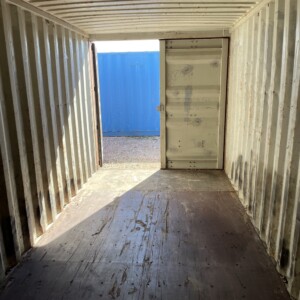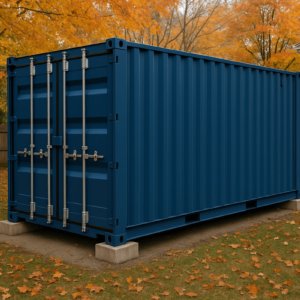Ever wondered how much a shipping container really weighs? A standard 20ft container usually weighs around 5,000 pounds empty, while a 40ft high cube can weigh in at over 8,500 lbs.
Factor in gross weight limits, trucking regulations, cargo distribution, and it’s easy to get overwhelmed. Understanding the specifics is important, especially for making sure containers can be transported safely, without getting fined for being overweight, and with shipping costs under control. So if you’re looking to purchase a used container for storage, international shipping, or just handling logistics in general, we’ve got you covered with the nitty-gritty details.
Shipping Container Weights at a Glance
| Container Type | Tare Weight (Empty) | Max Payload (Cargo Only) | Max Gross Weight (Container + Cargo) |
|---|---|---|---|
| 20ft Standard | 4,916–5,071 lbs (2,230–2,300 kg) | ~50,000 lbs (22,680 kg) | 55,126 lbs (25,000 kg) |
| 40ft Standard | 8,000–8,200 lbs (3,600–3,720 kg) | ~59,000 lbs (26,760 kg) | 67,200 lbs (30,480 kg) |
| 40ft High Cube | 8,600–8,800 lbs (3,900–3,990 kg) | ~58,000 lbs (26,300 kg) | 67,200 lbs (30,480 kg) |
| 40ft Reefer (Refrigerated) | 9,500–10,500 lbs (4,300–4,760 kg) | ~55,000 lbs (24,950 kg) | 65,000 lbs (29,480 kg) |
Container Weight Explained (What Really Impacts Your Bottom Line)
Shipping container weights aren’t arbitrary. They’re important because of the direct impact on:
- Freight Charges: Heavy containers cost more to ship
- Legal Limitations: Exceeding weight limits can get you fined up to $10,000 on road
- Safety Concerns: Improperly loaded heavy containers can lead to accidents or damage to loading equipment
- Equipment Choice: Container weights determine which cranes and forklifts you can safely rent
- Permitting: Transporting heavy containers may require special permits
Important: Container Weight Terminology Explained
Three Common Weight Terms Explained
1. Tare Weight
Weight of the empty container
Includes doors, roof, walls, and floor.
Example: 20ft container = approximately 5,071 lbs empty
2. Payload Capacity
Maximum weight of cargo the container can carry
Calculated as: Max Gross Weight – Tare Weight
Example: 20ft container = approximately 50,055 lbs of cargo
3. Gross Weight
Weight of fully loaded container (Container + Cargo)
The number you need for weight limits
Example: 20ft container = maximum 55,126 lbs total
What Affects Container Weight?
There are numerous variables that can impact the shipping container weight. These variables encompass the materials employed in the container’s construction, the specific container type, as well as additional elements that can exert a substantial influence on the overall weight of the container.
1. Construction Material
| Material | Weight Impact | Durability | Cost |
| Corten Steel | Standard weight | Excellent | $$$ |
| Aluminum | 30-40% lighter | Good | $$$$ |
| Steel Alloys | 5-10% heavier | Superior | $$$$ |
2. Container Age and Condition
- New containers: Exact manufacturer specifications
- Used containers: May have repairs/modifications that can add 100-500 lbs
- Rust and corrosion: Can add weight over time
3. Additional Features That Add Weight
- Double doors: +200-300 lbs
- Side doors: +400-500 lbs
- Ventilation systems: +50-100 lbs
- Insulation: +500-1,500 lbs
- Lock boxes: +20-50 lbs
- Bamboo flooring: -100 lbs (vs. hardwood)
4. Container Modifications
Common modifications and their weight impact:
- Windows: +50-100 lbs each
- Personnel doors: +150-200 lbs
- HVAC units: +200-400 lbs
- Electrical systems: +100-300 lbs
- Interior framing: +500-2,000 lbs
How to Calculate Total Shipping Weight (Step-by-Step)
Total shipping weight is determined by tare weight, the payload capacity, and the gross weight of a shipping container. Each is crucial in determining how much weight we can safely and efficiently ship.
Method 1: Straightforward Formula
Gross Weight = Tare Weight + Cargo Weight
Example Calculation:
- 20ft container tare: 5,071 lbs
- Your cargo: 45,000 lbs
- Total gross weight: 50,071 lbs ✓ (Under 55,126 lb limit)
Method 2: Reverse Calculation from Limits
Max Cargo Weight = Road/Rail Limit – Container Tare Weight
Example for US Highway:
- Highway limit: 80,000 lbs total
- Truck + chassis: 35,000 lbs
- Container tare: 5,071 lbs
- Cargo max: 39,929 lbs
Weight Limits and Legal Requirements
Limits by Mode of Transportation
Road Transport (USA)
- Federal highway maximum: 80,000 lbs (gross vehicle weight)
- State limits range: 73,000-105,500 lbs
- Note: Always verify state-specific regulations
Rail Transport
- Railcar capacity: 286,000 lbs capacity
- Ability: Accommodate 4-5 fully loaded 20ft containers
- Less weight-restrictive than road transport
Ocean Freight
- Ship capacity: Rarely the limiting factor
- Port handling equipment: Typically rated up to 88,000 lbs
- Consideration: Weight distribution is a primary concern
International Standards (ISO Requirements)
- ISO Standard 20ft container: Minimum rating of 52,910 lbs
- SO Standard 40ft container: Minimum rating of 67,200 lbs
- Safety factors: Generally set at 1.8x of max gross weight
Guide to Weighing a Loaded Shipping Container
You need to know the gross weight of a shipping container to safely transport it and meet transportation regulations. We will cover the significance of accurately weighing a container, container weighing methods, and how container weight distribution factors into container transportation.
1. Certified Truck Scales
- Price: $10-75 per weighing
- Accuracy: ±20 lbs
- Where to find: Most truck stops, grain elevators
- Process: Drive on loaded truck, receive certified weight ticket
2. Container Terminal Weighbridges
- Price: $50-150 per weighing
- Accuracy: ±10 lbs
- Note: ideal for export containers (SOLAS requirement)
- Receive: VGM (Verified Gross Mass) certificate
3. Calculated Weight Method
- Step 1: Weigh all cargo items individually
- Step 2: Add weight of packaging/securing materials
- Step 3: Add container tare weight
- Accuracy: ±2% if done correctly
How to Choose the Right Shipping Container for Your Needs
Weight vs. Space vs. Price Matrix – How to make the right decision?
When it comes to selecting the right container, it’s important to consider the weight carrying capacity, the external dimensions as well as the prices. All of these parameters must be considered before making a final choice, and the container should be selected in line with the type of goods to be transported.
Step 1: Assess Your Cargo Volume
- Heavy & Dense Cargo (machinery, metals, liquids): Opt for 20ft containers
- Why: Improved weight distribution, easier handling, cost-effective transport
- Shipping 40,000 lbs of steel would need Two 20ft containers, not One 40ft
- Light & Voluminous Cargo (furniture, textiles, plastics): Select 40ft or High Cube
- Why: Enhanced space utilization, reduced per-unit shipping cost
- Example: A furniture load weighing 15,000 lbs is packed in One 40ft instead of Two 20ft
Step 2: Consider Transport Limitations
| Your Situation | Best Container Choice | Reason |
| Limited crane capacity (< 70,000 lbs) | 20ft standard | Stays under equipment limits when loaded |
| Tight delivery location | 20ft standard | Easier maneuvering, smaller trucks |
| Highway transport in multiple states | 20ft or lightly loaded 40ft | Avoids overweight permits |
| Rail or ocean only | 40ft (any type) | No road weight restrictions |
| Temperature-controlled cargo | Reefer (accept weight penalty) | No alternative for cold chain |
Step 3: Factor in Total Costs
20ft Container Economics:
Pros:
- Lower purchase/rental price ($2,000-3,000)
- Less expensive transport for heavy loads
- Flexible routing options
Cons:
- Higher cost per cubic foot
- May need multiple containers
40ft Container Economics:
Pros:
- Best price per cubic foot
- Single container efficiency
- Reduced handling costs for volume shipments
Cons:
- Higher initial cost ($3,000-4,500)
- Weight restrictions on certain roads
Quick Guide to Selecting Container Size by Use Case
For Storage/Modification Projects:
- Small lot / backyard: 20ft (placement / permits easier)
- Commercial property: 40ft or 40ft HC (occupies most space)
- Container home: 40ft HC (extra ceiling height is worth extra weight)
For Shipping:
- International ocean freight: 40ft standard (best economics)
- Domestic trucking: 20ft or weight-conscious 40ft loading
- Intermodal (rail+truck): Either, but check final mile weight limits
For Specialty Needs:
- Hazardous materials: 20ft (better for emergency response)
- High-value goods: 20ft (less cargo at risk)
- Project cargo: Open-top or flat-rack containers
Pro Tips for Container Selection
Weight Distribution: Distribute weight if your cargo exceeds 40,000 lbs; splitting between two 20ft containers can offer more shipping options and reduced risk compared to fully loading one 40ft container.
75% Rule: Adhering to the 75% rule of maximum payload can accommodate securing materials, fluctuation in cargo weight, and safety margins.
Regional Variations: East Coast ports are equipped to manage 40ft containers, while West Coast logistics may favor 20ft containers for last-mile distribution – assess based on your route.
Conclusion
In conclusion, to optimize shipping and logistics, a detailed study of shipping container weight should be done. It can help one get an estimate of the maximum number of containers that can be shipped. It also ensures that you do not cross the weight limit of the shipping container. The empty weight of the shipping container can vary a lot, when it is loaded. So, the calculation of the gross weight of the shipping container is required. The gross weight of the shipping container is the tare weight and the payload weight together. By understanding shipping container weight and different types of shipping containers, we can make smarter shipping and logistics decisions.
Frequently Asked Questions
What is the weight of a standard 20-foot container when empty?
The weight of an empty twenty foot (TEU) container is on average 4,916 pounds or 2,230 kilograms. This figure represents the typical or tare weight of the container not including weight of goods or cargo that it may be carrying.
What is the typical weight of a 40-foot shipping container?
The average or tare weight of an empty forty foot container is 8,000 to 9,200 pounds. This weight may be higher or lower based on the model and materials used in its construction.
How are shipping container weights measured and reported?
The tare weight is the weight of the container itself when it is empty. The gross weight is the combined weight of the container and its cargo.
What is the maximum weight capacity of a typical shipping container?
A 20-foot container’s maximum weight is about 55,126 pounds (24,999 kilograms). Depending on the specific design, the maximum weight of a 40-foot container may be as high as 67,196 pounds (30,480 kilograms).





